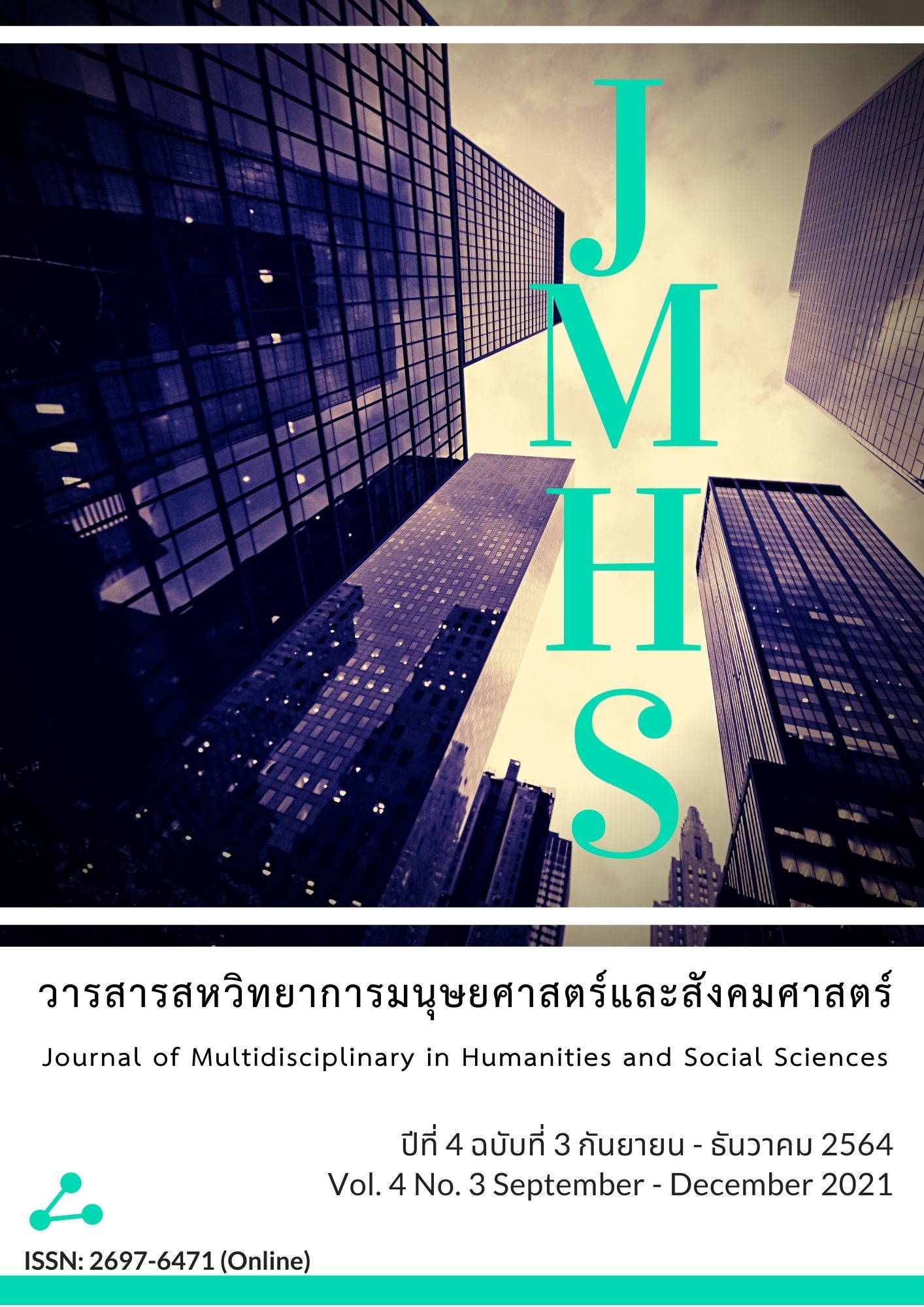Causal Relationship Model of Behavioral Purchase Intention a Discounted Product of H&M Brand on Facebook Page of Customers in Bangkok and Its Vicinity
Main Article Content
Abstract
This research aimed to develop and verify the consistency of the causal relationship model of behavioral purchase intention for a discounted product of the H&M brand on the Facebook page of customers in Bangkok and its vicinity with empirical data. The research’s latent variables consisted of 1) Discount Framing, 2) Brand Reputation, 3) Brand Image, 4) Purchase Intention, and 5) Behavioral Purchase Intention and latent variables were measured from 25 observed variables. The sample group used in the research was 250 people who used to buy discounted products on the H&M Facebook page and resided in Bangkok and its vicinity. The research tool was an online questionnaire. There are 7 levels of an approximation based on the Likert Scale. The statistics used in data analysis were frequency, percentage and structural equation model. The results of the research were as follows: The causal relationship model of behavioral purchase intention for a discounted product of H&M brand on the Facebook page was consistent with empirical data. The statistics showed the Chi-square statistics goodness fit test (2) = 279.51, degrees of freedom (df) = 219, CMIN/df = 1.28, GFI = 0.92, AGFI = 0.90, Standardized RMR = 0.03, RMSEA = 0.03. The variables in the model were able to explain 69% of the variance in behavioral purchase intention. Online business entrepreneurs can use it for marketing planning and creating strategies that suit consumers. As a result, the behavior purchase intention is to buy discounted products on the H&M Facebook page in the future.
Article Details
Views and opinions appearing in the Journal it is the responsibility of the author of the article, and does not constitute the view and responsibility of the editorial team.
References
กริช แรงสูงเนิน. (2554). การวิเคราะห์ปัจจัยด้วย SPSS และ AMOS เพื่อการวิจัย. กรุงเทพฯ: ซีเอ็ดยูเคชั่น.
ชไมพร กาญจนกิจสกุล. (2555). ระเบียบวิธีวิจัยทางสังคมศาสตร์. ตาก: โพรเจ็คท์ ไฟฟ์-ไฟว์.
ธัชนันท์ ศีลพิพัฒน. (2559). ปัจจัยที่มีอิทธิพลเชิงบวกต่อความตั้งใจซื้อเครื่องสำอางที่เป็นตราสินค้าจากสหรัฐอเมริกาของผู้หญิงวัยทำงานในกรุงเทพมหานคร(การค้นคว้าอิสระตามหลักสูตรบริหารธุรกิจมหาบัณฑิต). มหาวิทยาลัยกรุงเทพ.
นงลักษณ์ วิรัชชัย. (2542). โมเดลลิสเรล: สถิติวิเคราะห์สำหรับการวิจัย. (พิมพ์ครั้งที่ 3). กรุงเทพฯ: โรงพิมพ์แห่งจุฬาลงกรณ์มหาวิทยาลัย.
นิธินาถ วงศ์สวัสดิ์ และ ปวีณา คำพุกกะ. (2557). ความตั้งใจของผู้ซื้อขายหลักทรัพย์ผ่านอินเทอร์เน็ต. วารสารสมาคมนักวิจัย, 19(2), 56-67.
พวงเพชร ศิริโอด. (2558). ปัจจัยด้านความตั้งใจซื้อที่มีผลต่อพฤติกรรมการซื้อสินค้ามือสองของผู้บริโภคในตลาดนัด. นครราชสีมา: คลังปัญญา มหาวิทยาลัยเทคโนโลยีสุรนารี.
ศูนย์วิจัยกสิกรไทย. (2556). Fast Fashion Retailers บุกอาเซียน. สืบค้นเมื่อ 1 มีนาคม 2564, จาก https://kasikornresearch.com/th/analysis/k-econ/business/Pages/31823.aspx
สำนักงานพัฒนาธุรกรรมทางอิเล็กทรอนิกส์. (2562ก). รายงานผลการสำรวจมูลค่าพาณิชย์อิเล็กทรอนิกส์ในประเทศไทย ปี 2562. สืบค้นเมื่อ 1 มีนาคม 2564, จาก https://www.etda.or.th/th/https/www-etda-or-th/th/newsevents/pr/Value-of-e-Commerce-Survey-in-Thailand-2019.aspx
สำนักงานพัฒนาธุรกรรมทางอิเล็กทรอนิกส์. (2562ข). Thailand Internet User Behavior. สืบค้นเมื่อ 14 พฤศจิกายน 2563, จาก https://www.etda.or.th/th/NEWS/ETDA-Revealed-Thailand-Internet-User-Behavior-2019.aspx
Agmeka, F., Wathoni, R. N., & Santoso, A. S., (2019). The Influence of Discount Framing Towards Brand Reputation and Brand Image on Purchase Intention and Actual Behavior in e-Commerce. Procedia Computer Science, 161, 851-858.
Banerjee, S. (2009). Effect of Product Category on Promotional Choice: Comparative Study of Discounts and Freebies. Management Research News, 32(2), 120-131.
Bivainiene, L. (2007). Brand Image Conceptualization: The Role of Marketing Communication. Journal of Economics and Management, 12(1), 304-310.
Canniere, M. H. D., Pelsmaker, P. D., & Geuens, M. (2007). Relationship Quality and The Theory of Planned Behavior Models of Behavioral Intentions and Purchase Behavior. Journal of Business Research, 62(1), 82-92.
Darke, P. R., & Chung, C. M. Y. (2005). Effects of Pricing and Promotion on Consumer Perceptions: It Depends on How You Frame It. Journal of Retailing, 81(1), 35-47.
Das, G. (2014). Linkages of Retailer Personality, Perceived Quality and Purchase Intention with Retailer Loyalty: A study of Indian Non-Food Retailing. Journal of Retailing and Consumer Services, 21(3), 407-414.
Esmaeilpour, F., & Abdolvand, M. A. (2016). The Impact of Country-of-Origin Image on Brand Loyalty: Evidence from Iran. Asia Pacific Journal of Marketing and Logistics, 28(4), 709-723.
Haward, J. A. (1994). Buyer Behavior in Marketing Strategy. Englewood Cliffs, NJ.: Prentice Hall.
Hoelter, J. W. (1983). The Analysis of Covariance Structures: Goodness-of-fit Indices. Sociological Methods and Research, 11(3), 325–344.
Kline, R. B. (2011). Principles and Practice of Structural Equation Modeling. (3rd ed.). New York: The Guilford Press.
Kotler, P. (2000). Marketing Management. (10th ed.). New Jersey: Prentice-Hall.
Stavros, P. K., Michael, P., Robert, E., & Markos, H. T. (1999). Green Marketing and Ajzen's Theory of Planned Behavior: A Cross-Market Examination. Journal of Consumer Marketing, 16(5), 441-460.
Sung, H. H., Bang, N., & Timothy, J. L. (2015). Consumer-Based Chain Restaurant Brand Equity, Brand Reputation, and Brand Trust. International Journal of Hospitality Management, 50(1), 84–93.
Veloutsou, C., & Moutinho, L. (2009). Brand Relationships through Brand Reputation and Brand Tribalism. Journal of Business Research, 62, 319-322.
Venkatesh, V., Brown, S. A., Maruping, L. M., & Bala, M. H. (2008). Predicting Different Conceptualizations of System USE: The Competing Roles of Behavioral Intention, Facilitating Conditions, and Behavioral Expectation. MIS Quarterly: Management Information Systems, 32(3), 483-502.


